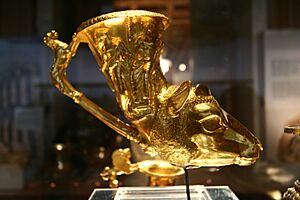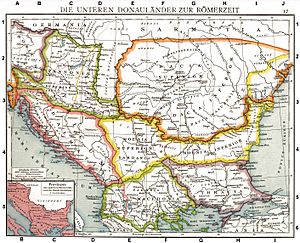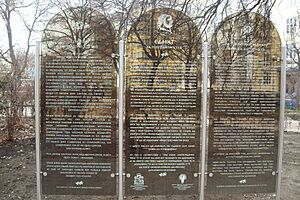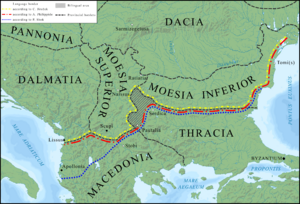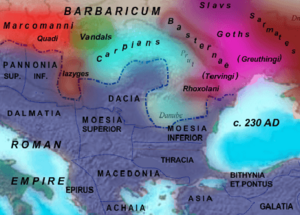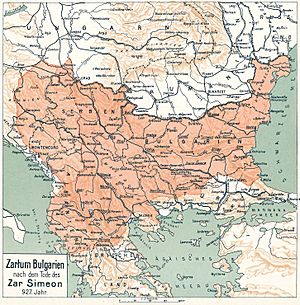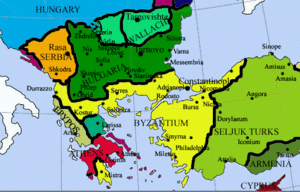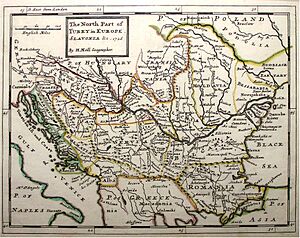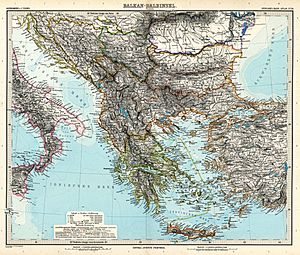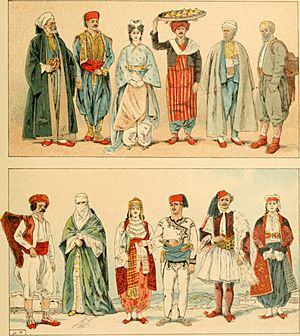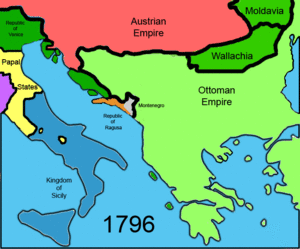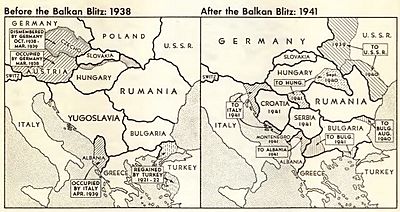History of the Balkans facts for kids
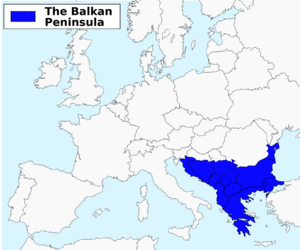
The Balkans is a region in Southeast Europe. It's a place with a unique identity and many different groups of people. This is because of its long and often difficult history, especially centuries under the Ottoman Empire, and its very mountainous geography.
Contents
- Ancient Times: Early Settlements and Cultures
- Classical Civilizations and Empires
- Roman Rule and the Rise of Christianity
- The Middle Ages: Empires and Migrations
- Modern Times: Nationalism and Wars
- The Balkans Today: 21st Century
- Overview of State Histories
- Cultural History
- See also
- Primary sources
Ancient Times: Early Settlements and Cultures
First People in Europe: Mesolithic Age
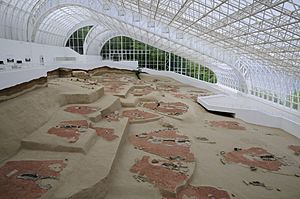
The first known human settlement in Europe was the Iron Gates Mesolithic culture. This was from about 11,000 to 6,000 BC. It was located along the Danube River in what is now Serbia and Romania. People have called it "the first city in Europe." This is because people lived there permanently, had an organized society, and used advanced building methods.
New Ways of Life: Neolithic Age
Later, archaeologists found several early cultures in the Balkans. These include the Cucuteni culture (4500 to 3500 BC), Starcevo culture (6500 to 4000 BC), and Vinča culture (5500 to 3000 BC).
A very special discovery was the Varna Necropolis in Bulgaria. This culture (4600–4200 BC) created the world's oldest known gold treasure! It shows they had complex beliefs about life after death. Also, the Tartaria tablets found in Romania seem to have very early forms of writing.
Copper Age and Early Tribes
Around 1000 BC, Illyrian tribes appeared in areas like modern Albania, Montenegro, Bosnia and Herzegovina, and Croatia. The Thracians lived in Thrace (now mainly Bulgaria). The related Dacians lived in what is now Romania. These groups spoke ancient Indo-European languages.
Classical Civilizations and Empires
Iron Age: Greeks and Persians
Starting around the 9th or 8th century BC, classical Greek culture grew in the southern Balkans. It reached its peak with democracy in Athens in the 6th and 5th centuries BC. The Greeks were the first to set up trade routes in the Balkans. They founded many colonies along the Black Sea and other coasts to help with trade.
By the late 4th century BC, Greek language and culture were very important across the Eastern Mediterranean. Later, the Persians invaded the Balkans. They ruled parts of Thrace, Paeonia, and Macedon for some time. However, after the Greco-Persian Wars, the Persians had to leave most of their European lands.
Important local kingdoms also formed. The Odrysian kingdom was a strong Thracian state, founded around 470 BC in what is now central Bulgaria. The Illyrian tribes lived along the Adriatic coast.
Before the Romans: Powerful Kingdoms
In the 4th century BC, Bardylis, an Dardanian leader, created a strong Illyrian kingdom. But Philip II of Macedon, father of Alexander the Great, later defeated the Illyrians. Alexander himself also fought Illyrian forces. After Alexander's death, independent Illyrian states rose again.
By the end of the 3rd century BC, an Illyrian kingdom in Scodra (modern Shkodra, Albania) controlled parts of northern Albania and coastal Montenegro. Under Queen Teuta, Illyrians attacked Roman ships. This gave Rome a reason to invade the Balkans.
In the Illyrian Wars (229 BC and 219 BC), Rome took over Illyrian settlements and stopped piracy. In 168 BC, the Romans defeated king Gentius, the last king of Illyria. They also defeated Perseus, the last King of Macedonia. This made Rome the main power in the region.
Roman Rule and the Rise of Christianity
The Roman Period: Stability and Influence
Starting in the 2nd century BC, the growing Roman Republic began to take over the Balkan area. It became a very rich and stable part of the Roman Empire. Even today, you can see Roman buildings and artifacts everywhere. Also, the Balkan Romance languages spoken by millions of people are based on Latin. However, Greek culture remained strong in the southern Balkans and the eastern part of the Empire.
From the 3rd century AD, Rome's borders in the Balkans became weaker due to internal problems. But the Balkans, especially Illyricum, became very important. Many Roman emperors, soldiers, and leaders came from this region.
Later, groups like the Thervings, Greuthungs, and Huns began to cross into the Empire. Some came as refugees, others as invaders. The Visigoths under Alaric I eventually conquered and destroyed much of the Balkan region before moving into Italy.
Christianity Comes to the Balkans
Christianity first arrived in the Balkans when Saint Paul traveled through Greek, Thracian, and Illyrian areas. He spread Christianity in cities like Thessaloniki and Corinth. Saint Andrew also preached in the region.
In 311 AD, Emperor Galerius issued the Edict of Serdica in Serdica (modern Sofia, Bulgaria). This officially ended the persecution of Christians in the East. In 313, Emperor Constantine issued the Edict of Milan, which stopped all Roman persecution of Christianity. By 391, Theodosius I made Christianity the official religion of Rome.
Later, the East-West Schism (also called the Great Schism) divided Christianity into Western Catholicism and Greek Eastern Orthodoxy. This happened around 1054. The main reasons were disagreements over the Pope's authority and differences in religious practices.
The Middle Ages: Empires and Migrations
The Eastern Roman Empire: Byzantium
The Byzantine Empire was the Greek-speaking Eastern Roman Empire during the Middle Ages. Its capital was Constantinople. It controlled many areas in the Balkans. The Byzantines were very important for protecting Western Europe from invasions from the East. They also preserved ancient knowledge and developed a new legal code, the Corpus Juris Civilis.
Byzantine missionaries spread Orthodox Christianity to many Slavic peoples in Eastern Europe, where it is still a main religion today. Jewish communities, especially Romaniotes, also lived throughout the Balkans and influenced the local cultures.
The Byzantine Empire's borders changed a lot. It often fought with Arabs, Persians, Turks, and even other Christians like the Bulgarians, Serbs, and Crusaders. Eventually, the empire shrank to just Constantinople and small areas in Greece. In 1453, Mehmet II and the Ottoman Empire conquered Constantinople, ending the Byzantine Empire.
Barbarian Invasions and New Peoples
As the Roman Empire declined, many "barbarian" tribes moved through the Balkans. Most did not stay long. During these "Dark Ages," Eastern Europe saw a decline in culture and economy.
- Goths: The Goths moved south into the Roman Balkans, pushed by the Huns. Some were allowed to settle as allies, but they rebelled and defeated the emperor in 378.
- Huns: The Huns, led by Attila the Hun, entered Europe around 400-410 AD. They created a huge empire of terror. But after Attila's death in 454 AD, their power quickly collapsed.
- Slavs: The Slavs, known as the Sklavenoi, migrated in large numbers from Central and Eastern Europe starting in the 6th century. They became the South Slavs.
- Avars: The Avars were a Turkic group that entered Central Europe in the 7th century. They often raided the Balkans, adding to the region's decline.
- Bulgars: The Bulgars, a Turkic people from Central Asia, arrived in the Balkans in the 7th century. Led by Asparuh, they settled in what is now Bessarabia. In 680 AD, they invaded Moesia and Dobrudja and formed a union with local Slavic tribes. This led to the establishment of Bulgaria in 681 AD.
- Magyars: The Magyars settled in the Carpathian Basin at the end of the 9th century. They were a Uralic people who learned horseback warfare from Turkic groups.
First Bulgarian Empire: A Strong Power
In the 7th century, the First Bulgarian Empire was founded by Khan Asparuh. It grew very strong, stretching from the Dnieper River to Budapest and the Mediterranean. Bulgaria was a major power in the Balkans for four centuries. It played a key role in spreading Christianity and the Bulgarian Alphabet among other Slavs.
Republic of Venice: A Sea Power
The Republic of Venice became a powerful trading empire. It controlled much of the trade in the Balkans and many islands in the Aegean Sea. After the Fourth Crusade in 1204, Venice helped conquer and divide the Byzantine Empire. This allowed Venice to gain even more control in the Aegean.
Serbian Empire: A Brief Golden Age
In 1346, the Serbian Empire was founded by King Stefan Dušan (known as "Dušan the Mighty"). Under his rule, Serbia became the main power in the Balkans. It was a large empire stretching from the Danube to the Gulf of Corinth. Dušan also created Dušan's Code, an important law book for Medieval Serbia. After his death in 1371, the empire quickly broke apart.
Ottoman Invasion: A New Era
In the 14th century, Ottoman rule began to spread over the Eastern Mediterranean and the Balkans. The Ottoman state captured important cities like Bursa (1326) and Thessaloniki (1387). The Ottoman victory at Kosovo in 1389 greatly weakened Serbian power.
In 1453, Mehmed the Conqueror captured Constantinople. This made the Ottoman Empire the leading power in southeastern Europe. The Ottomans allowed the Eastern Orthodox Church to keep its independence and lands in exchange for accepting Ottoman rule.
Modern Times: Nationalism and Wars
Ottoman Rule in the Early Modern Period
Much of the Balkans was under Ottoman rule for a long time, from the 14th century until the early 20th century in some places. The Ottoman Empire was very diverse in religions, languages, and ethnic groups. It often allowed different religious practices, sometimes more than other parts of the world.
The Ottoman rulers mostly controlled the region indirectly. In some areas, local leaders paid tribute but had little other contact. The Ottoman Empire collected taxes but generally did not force labor. The Sultan often protected the Orthodox clergy.
Rise of Nationalism: New Nations Form
The rise of Nationalism in the Ottoman Empire led to the breakdown of the old system. People started to identify more with their own ethnic groups and wanted their own independent states. This led to several important events:
- Bulgarian National Revival (18th-19th century)
- Serbian Revolution (1804–1815)
- Greek War of Independence (1821–1832)
- Albanian National Awakening (1830-1912)
A Serbian revolt in Herzegovina in 1875 led to the Russo-Turkish War (1877–1878). This war resulted in the Liberation of Bulgaria and Serbia in 1878.
The Congress of Berlin (1878)
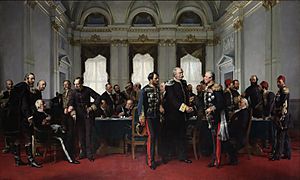
The Congress of Berlin was a meeting of European leaders in 1878. Its goal was to stabilize the Balkans after Russia's victory over Turkey. German Chancellor Otto von Bismarck led the meeting.
As a result, the Ottoman Empire lost much of its land in Europe. Bulgaria became an independent principality. Serbia and Montenegro gained full independence, though with smaller territories. Austria-Hungary took control of Bosnia and Herzegovina. Britain gained Cyprus.
While initially seen as a success for peace, many countries were not fully happy. This led to more tensions, especially between Russia and Austria-Hungary, and among the Balkan nations themselves. These unresolved issues contributed to future conflicts.
The 20th Century: World Wars and Cold War
Balkan Wars (1912-1913)
The Balkan Wars were two wars fought in 1912 and 1913. In the first war, four Balkan states defeated the Ottoman Empire, taking almost all its remaining land in Europe. In the second war, Bulgaria was defeated by its former allies. These wars set the stage for World War I.
World War I (1914-1918)
World War I started in the Balkans. A Bosnian Serb named Gavrilo Princip assassinated Franz Ferdinand, the heir to the Austrian throne, in July 1914. This led Austria-Hungary to declare war on Serbia.
Austria-Hungary wanted to defeat Serbia, partly because they feared Serbia's growing power and its desire to unite South Slavs. However, their invasion of Serbia in 1914 was difficult. The Serbian army fought bravely and inflicted heavy losses on the Austro-Hungarians.
Bulgaria joined the Central Powers in 1915, hoping to gain land in Macedonia. They helped occupy Serbia. Romania joined the Allies in 1916. The war caused huge economic problems and many deaths across the Balkans.
Consequences of World War I
The war completely changed the borders of many states. The new Kingdom of Serbs, Croats, and Slovenes, later called Yugoslavia, was created. Both Austria-Hungary and the Ottoman Empire were officially dissolved. This changed the balance of power and ethnic makeup of the region.
There were also large population movements. For example, almost 1.5 million Greeks moved from Turkey to Greece, and about 700,000 Turks moved from Greece to Turkey.
World War II (1939-1945)
World War II in the Balkans began with Italy's attempts to create an empire. Italy invaded Albania in 1939 and Greece in 1940. When Greece resisted, Germany intervened in 1941, invading Yugoslavia and then Greece.
After conquering Yugoslavia, Nazi Germany created puppet states like the Independent State of Croatia. The Germans and their allies then invaded Greece. Despite strong resistance, the Germans took control of both countries. The Balkan borders were reshuffled again, with new puppet states and annexations.
Aftermath of World War II and the Cold War
After World War II, most Balkan countries came under communist governments supported by the Soviet Union. However, Yugoslavia (led by Josip Broz Tito) and Albania broke away from Soviet influence. Yugoslavia sought closer ties with the West and created the Non-Aligned Movement. Albania became more isolationist and allied with Communist China for a time. Greece and Turkey remained non-communist and joined NATO.
Despite communist rule, nationalism remained. For example, in Bulgaria, the government tried to force ethnic Turks to change their names, leading to many fleeing to Turkey.
Post-Communism and Yugoslav Wars
In the late 1980s and early 1990s, communism collapsed in Eastern Europe. This brought political and economic changes to the Balkans, including moves towards a market economy.
Yugoslav Wars (1991-2001)
The collapse of Yugoslavia led to a series of wars. Different groups wanted to keep power or create their own independent states. The conflicts caused many civilian deaths and huge damage to cities like Sarajevo and Dubrovnik.
The Ten-Day War in Slovenia in 1991 was short. But the Croatian War of Independence (1991) and the war in Bosnia and Herzegovina (1992-1995) were very destructive. Events like the Srebrenica massacre highlighted the terrible violence. The Dayton Agreement in 1995 brought peace to Bosnia.
These wars caused large numbers of people to flee their homes, especially those who were ethnic minorities in certain areas. Many leaders and politicians were later tried for war crimes by the International Criminal Tribunal for the Former Yugoslavia.
In 1999, the Kosovo War led to NATO bombing Yugoslavia. Kosovo became a protectorate, and many ethnic Albanians were forced to flee, though this was later reversed.
The Balkans Today: 21st Century
Since 2000, many Balkan countries have moved towards closer ties with Europe.
- Greece has been a member of the European Union since 1981.
- Slovenia and Cyprus joined the EU in 2004.
- Bulgaria and Romania joined the EU in 2007.
- Croatia joined the EU in 2013.
- North Macedonia is a candidate for EU membership, and other Balkan countries also want to join.
Many Balkan countries are also part of NATO:
- Greece has been a member since 1952.
- Bulgaria, Romania, and Slovenia joined in 2004.
- Croatia and Albania joined in 2009.
In 2006, Montenegro became independent from Serbia and Montenegro. In 2008, Kosovo declared its independence from Serbia, though it is still only partially recognized by other countries. Since the 2008 economic crisis, former Yugoslav countries have started to cooperate more, similar to how they did when they were part of Yugoslavia.
Overview of State Histories
- Albania: The ancestors of Albanians were likely Illyrian tribes. After Roman rule, Albania was under Byzantine and then Bulgarian control. The first Albanian state, the Principality of Arbër, formed in the Middle Ages. It was conquered by the Ottoman Empire in the 15th century and remained under their rule until 1912, when it declared independence.
- Bosnia and Herzegovina: This territory was historically divided between Croatia and Serbia. It later became the Banate of Bosnia and then the Kingdom of Bosnia under Tvrtko. After the Ottoman conquest, much of the population converted to Islam. Austria-Hungary took control in 1878. It joined Yugoslavia and gained full independence after the Bosnian War.
- Bulgaria: The Bulgars settled in the Balkans in 680 AD, forming the First Bulgarian Empire with local Slavs. Bulgaria became Christian in the 9th century and was a major power, spreading the Cyrillic alphabet. After a period of Byzantine rule, the Second Bulgarian Empire was restored in 1185. Most Bulgarian lands fell to the Ottomans by 1422. Bulgaria was liberated in 1878.
- Croatia: Croat tribes formed two duchies after Slavic settlement. The Kingdom of Croatia was founded in 925. In 1102, it joined a union with Hungary. Parts of Croatia fell to the Ottomans, and the rest came under Austrian rule. Croatia joined Yugoslavia in 1918 and gained independence after the Croatian War.
- Greece: Greece is home to some of Europe's oldest civilizations, including the Minoan civilization and the Mycenaean Greek civilization. The history of Greece is very long and complex, with its influence and territory changing over time.
- Montenegro: In the 10th century, the area had several principalities. Duklja gained independence from the Byzantines in the 11th century. It later came under Serbian rule. By the 15th century, the region was known as Crna Gora (Montenegro). Large parts were under Ottoman control from 1496 to 1878. Montenegro gained independence in 1878 and was part of Yugoslavia until it became independent again in 2006.
- North Macedonia: North Macedonia celebrates its independence from Yugoslavia on September 8, 1991. Another important day is August 2, marking the start of the Ilinden Uprising.
- Serbia: After Slavic settlement, Serbs established several principalities. Serbia became a kingdom in 1217 and an empire in 1346. The entire territory was annexed by the Ottoman Empire by the 16th century. The Serbian Revolution in the early 19th century re-established the Serbian state. After World War I, Serbia formed Yugoslavia with other South Slavic peoples. Serbia regained its independence in 2006.
Cultural History
Albanian Culture
Albanian culture is rich and diverse, shaped by its unique history and location in the Balkans.
Byzantine Culture
Byzantine culture, from the Eastern Roman Empire, had a huge impact on the Balkans, especially through Orthodox Christianity and its art, architecture, and legal traditions.
Bulgarian Culture
Bulgarian culture has a long history, especially during the Golden Age of medieval Bulgarian culture in the Middle Ages, when it was a major center for Slavic literature and art.
Serbian Culture
Serbian culture is deeply rooted in its medieval history, including its strong Orthodox Christian traditions and unique folk customs.
Ottoman Culture
Ottoman culture, brought by the Ottoman Empire, influenced many aspects of life in the Balkans, from architecture and food to music and social customs.
Eastern Orthodoxy
Eastern Orthodoxy is a major religion in the Balkans, playing a central role in the cultural and historical identity of many nations in the region.
|
See also
 In Spanish: Historia de los Balcanes para niños
In Spanish: Historia de los Balcanes para niños
- History of Albania
- History of Bosnia and Herzegovina
- History of Bulgaria
- History of Croatia
- History of Greece
- History of Kosovo
- History of North Macedonia
- History of Montenegro
- History of Romania
- History of Serbia
- History of Slovenia
- History of Yugoslavia
- History of Europe
- Historical regions of the Balkan Peninsula
- Rise of nationalism in the Ottoman Empire
Primary sources


